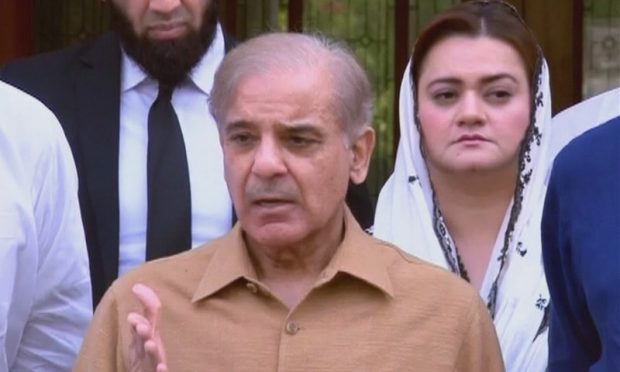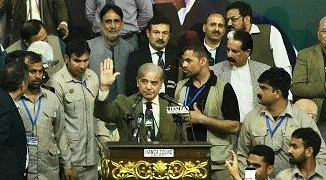Shahbaz Sharif elected Pakistan’s 31st Prime Minister

Shahbaz Sharif. (Dawn)
By Nasir Aijaz
The AsiaN Representative
Islamabad: Mian Muhammad Shahbaz Sharif, President of Pakistan Muslim League (Nawaz Sharif), known as PML-N, was elected as the new Prime Minister of the country seeking 174 votes of the National Assembly members on Monday afternoon.
He has replaced Pakistan Tehreek-e-Insaf (PTI) chief Imran Khan, who was ousted from premiership through a no-confidence motion moved against him at midnight on April 9, 2022.
The voting for election of a new Leader of House was held in the absence of PTI members who boycotted the election process and left the house.
The PTI had nominated former Foreign Minister Shah Mahmood Qureshi to contest against Mian Shahbaz Sharif, but he couldn’t get a single vote, as he and his other party members had announced the boycott.
The national assembly has 342 seats, of which one was vacant. These seats include 272 General Seats, 60 seats reserved for women and 10 for non-Muslims.
The PTI won 122 seats in election held in 2018 and later its strength rose to 155 after getting 28 women and five non-Muslims elected on reserved seats. Even after that PTI had to seek support of other smaller political groups/parties and independent members to form a coalition government.
Three members of Grand Democratic Alliance, the PTI ally from Sindh province, however didn’t boycott the process, while its other allies – Muttahida Qaumi Mahaz – Pakistan, an ethnic group from Sindh province and Balochistan Awami Party (BAP) had already joined hands with Combined Opposition to remove Imran Khan.
When the National Assembly, the lower house of parliament, met at 2.30p.m, Deputy Speaker Qasim Suri, hailing from PTI, was in the chair as the Speaker Asad Qaiser, also the PTI-loyalist, had tendered his resignation on April 9, refusing to conduct proceedings of no-confidence motion against Imran Khan.
As was expected, Mr. Suri too, following the footsteps of Qaiser and his party’s strategy, declined to be the part of election of the new Leader of House, and invited Sardar Ayaz Sadiq, member of panel of chair, to preside over the session.
As Mr. Suri was the person, who, as Deputy Speaker, had rejected the Combined Opposition’s no-confidence motion earlier on April 3, defended his action in a brief speech and reiterated allegations that the opposition’s no-trust motion was foreign-instigated. He also showed a sealed letter to the house, which he said, would be submitted in the Supreme Court.

Shahbaz Sharif
Again, as per PTI strategy, before quitting the Speaker’s seat, Mr. Suri invited his party’s ex-Foreign Minister Shah Mahmood Qureshi to address the house who, in his half an hour speech, full of accusations, dubbed all the parties who ousted them, as ‘Imported’ declaring that they will not accept the rulers imposed by foreign powers.
Concluding his speech, Mr. Qureshi announced that he and his all the party legislators are boycotting the election process. PTI has also announced it would hold protest demonstrations and gain popular support. In few cities PTI supporters held demonstrations to show street power.
Mr. Qureshi, known as the fire-brand orator, is a feudal lord and Caretaker of a Mystic Saint of South Punjab. His political career during the Military Dictator Gen. Zia, who had toppled the civilian government of Pakistan People’s Party (PPP) in 1977 and hanged Zulfiqar Ali Bhutto, the first elected Prime Minister of the country in 1979.
Mr. Qureshi’s father was a close friend of Gen. Zia. Surprisingly, Mr. Qureshi later joined PPP and was made the Foreign Minister but at a later stage parted ways and joined PTI after its emergence on the political scene.
Mian Shahbaz Sharif, who is to be sworn in as new Prime Minister, is the younger brother of Mian Nawaz Sharif, who enjoyed premiership for three times, and was last ousted and disqualified in 2017 on corruption and other charges.
Currently he is out of country. Both the brothers also emerged on the political scene during Dictator Gen. Zia.
Mian Nawaz Sharif, an industrialist, was made Finance Minister of Punjab province by Gen. Zia. Later, when Ms. Benazir Bhutto, the daughter of Zulfiqar Ali Bhutto, was elected Prime Minister in December 1988, Mian Nawaz Sharif won the polls in Punjab and became the Chief Minister. He was a political opponent of PPP and Benazir Bhutto and was part of conspiracies against her government. Whenever Mian Nawaz Sharif held the office of Prime Minister, his brother Shahbaz Sharif used to be the Chief Minister of Punjab.
None of Pakistan Premiers could complete his tenure
Unfortunately, none of the Prime Ministers of Pakistan could complete his 5-year tenure. Liaquat Ali Khan, the first non-elected Prime Minister of newly created country, who assumed the office on August 15, 1947, was assassinated on October 16, 1951 during a public meeting at the same ground in Rawalpindi city of Punjab where Benazir Bhutto was assassinated on December 27, 2007 in a public meeting.
After Liaquat Ali Khan, seven other non-elected premiers were hardly able to serve for brief periods ranging from few months to one or two years till December 1971 when Pakistan broke up as a result of the war with India.
Zulfiqar Ali Bhutto became the 9th premier in 1973 but e hwas toppled by Gen. Zia in July 1977. During the military rule, Muhammad Khan Junejo was elected premier as a result of non-party polls in 1985 but he was removed by Gen. Zia in May 1988. In August, Gen. Zia died in air crash.
After a long period of military rule of Gen. Zia (The 3rd military rule of Gen. Ayub Khan and Gen. Yahya), the elections were held in October 1988 and Benazir Bhutto came to power in December/ However, her government was dismissed and Ghulam Mustafa Jatoi (a former loyalist and Chief Minister during Zulfiqar Ali Bhutto government) was appointed as Caretaker Prime Minister for three months.
As a result of fresh polls, Mian Nawaz Sharif was elected the Prime Minister who held the office from November 1990 to April 1993, when he was dismissed and a caretaker premier Balakhsher Mazari was appointed but Mian Nawaz Sharif was reinstated in May 1993 just to be removed again after two months when Moin Qureshi assumed as Caretaker premier.
In October 1993, Benazir Bhutto swept the polls and became Prime Minister but was dismissed in November 1996. This time Malik Mairaj Khalid was appointed Caretaker Prime Minister and as a result of elections Mian Nawaz Sharif became Prime Minister from February 1997 to October 1999 when Gen. Pervez Musharraf toppled his government and imposed military rule.
The dictator held general polls in 2002 which brought Mir Zaffarullah Jamali to power and who could serve from November 2002 to June 2004.
After his removal, Chaudhry Shujaat was made Prime Minister for two months till Shaukat Aziz, a professional from the World Bank. was imported to get him elected on a vacant seat. Shaukat Aziz remained in office from August 2004 to November 2007.
Again, Muhammad Mian Soomro was brought as Caretaker to hold the polls. This time, the PPP formed the government and Syed Yousuf Raza Gilani was made the Prime Minister on March 25, 2008 but he was removed on April 25, 2012 after the court disqualified him in a corruption case.
The PPP replaced him with Raja Pervez Ashraf who could continue from June 2012 to March 2013. New Caretaker Mir Hazar Khan Khoso held the polls and Mian Nawaz Sharif came into power in June. but he was removed and disqualified through a court verdict in July 2017.
His party appointed Shahid Khaqan Abbasi as premier in August 2017 and he served till May 2018 when retired judge Nasir-ul-Mulk was appointed as caretaker premier.
Imran Khan was elected to hold office in August 2018 and was removed on April 9, 2022.
Out of all the premiers listed above, first eight were non-elected while since 1990s, seven caretaker premiers were appointed in Pakistan. Mian Shahbaz Sharif is the 31st Prime Minister of the country.





















































